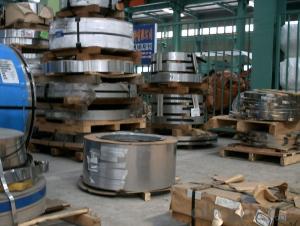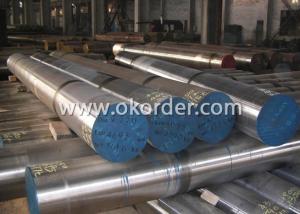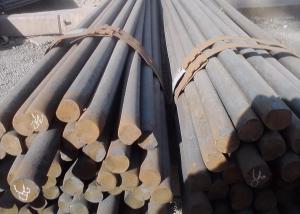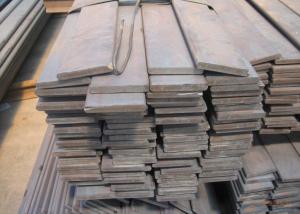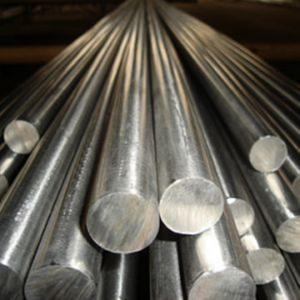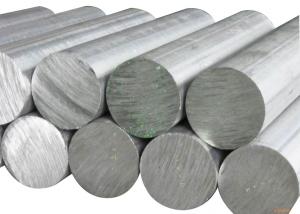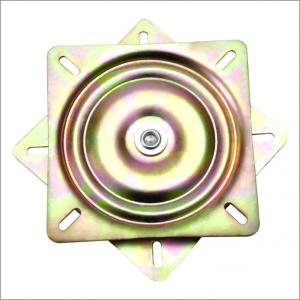Bulk rolled galvanized spring steel with grade A quality
- Loading Port:
- Tianjin
- Payment Terms:
- TT or LC
- Min Order Qty:
- 34 m.t.
- Supply Capability:
- 35000 m.t./month
OKorder Service Pledge
Quality Product, Order Online Tracking, Timely Delivery
OKorder Financial Service
Credit Rating, Credit Services, Credit Purchasing
You Might Also Like
Specifications
A.Size:9/10/12.5/14/16/19/25mm(wide)
B.Function:for handtools
C.Material:65M
D.Anti-rust
Quick Details
| Place of Origin: | Tianjin China (Mainland) | Brand Name: | HX | Model Number: | 65 |
| Style: | Flat;Leaf;Plate | Load Type: | Compression | Material: | Steel |
| Usage: | Industrial | Strength: | ingenuous structure with good obdurability | Color: | By customer |
| Matertial: | 65Mn | Width: | 9/10/12.5/14/16/19/25mm(wide) | Lengh: | Endless |
| Thickness: | 0.36-1.2mm | Using scope: | Tape measure and so on | Design: | spring steel for springs |
| Attributes: | Anti-rust | Firmness: | Best |
Packaging & Delivery
| Packaging Detail: | spring steel for springs 1pcs/roll,10pcs/paper wrap,500pcs/carton |
| Delivery Detail: | 15~25days |
Specifications
spring steel for springs
A.Size:9/10/12.5/14/16/19/25mm(wide)
B.Function:for handtools
C.Material:65M
D.Anti-rust
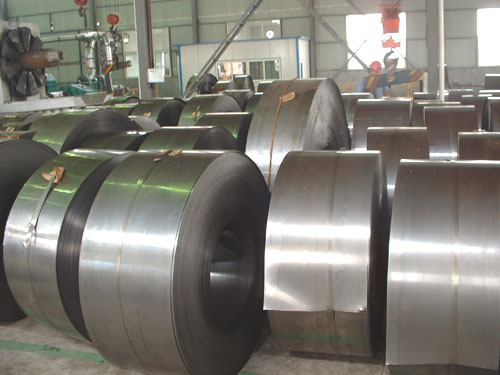

- Q:How does the microstructure of special steel affect its performance?
- The microstructure of special steel plays a significant role in determining its performance. Special steels are alloyed with specific elements to enhance their properties and meet specific application requirements. The microstructure refers to the arrangement of the steel's crystalline grains and the presence of any phase transformations within the material. One critical aspect of the microstructure is the grain size. Fine-grained structures, achieved through controlled cooling or alloying additions, offer improved strength, hardness, and toughness. Smaller grain sizes hinder the movement of dislocations within the material, resulting in increased strength and hardness. This is particularly crucial in applications that require high strength-to-weight ratios, such as aerospace or automotive components. Another crucial factor is the presence of various phases in the microstructure. The addition of specific alloying elements can promote the formation of different phases, such as martensite, bainite, or ferrite. These phases have different mechanical properties, such as hardness, toughness, and corrosion resistance. By carefully controlling the microstructure, it is possible to tailor the steel's performance to specific applications. For example, martensitic structures offer high hardness and wear resistance, ideal for cutting tools, while bainitic structures provide a good balance of strength and toughness, suitable for structural components. Furthermore, the microstructure also governs the steel's response to heat treatment processes, such as quenching and tempering. Heat treatments can modify the microstructure to achieve desired mechanical properties, such as increasing hardness or improving resistance to fatigue. The microstructure's ability to transform during heat treatment allows for precise control over the steel's performance characteristics. In summary, the microstructure of special steel significantly affects its performance. Grain size, phase distribution, and response to heat treatment are all key factors that determine the steel's mechanical properties and suitability for specific applications. By understanding and manipulating the microstructure, engineers can design special steels with enhanced performance, meeting the stringent demands of various industries.
- Q:How does special steel contribute to the automotive industry?
- Special steel plays a crucial role in the automotive industry by providing high strength, durability, and corrosion resistance properties, which are essential for various automotive components. This type of steel is used in manufacturing critical components such as engine parts, chassis, suspension systems, and safety features like airbags and seatbelt mechanisms. It not only improves the overall performance and safety of vehicles but also helps in reducing weight, enhancing fuel efficiency, and meeting stringent emission standards.
- Q:How does precipitation hardening enhance the strength of special steel?
- Precipitation hardening is a heat treatment process that enhances the strength of special steel by creating small, uniformly dispersed particles within the metal matrix. These particles act as obstacles to dislocation movement, making it more difficult for them to slide past each other and deform the material. This results in increased strength, hardness, and resistance to wear and fatigue, making the steel suitable for various demanding applications.
- Q:How is the hardness of special steel measured?
- The hardness of special steel is typically measured using methods such as Rockwell, Brinell, or Vickers hardness tests, which involve indenting the steel surface with a known force and measuring the resulting indentation size.
- Q:What are the different surface hardening techniques for special steel?
- There are several surface hardening techniques for special steel, including carburizing, nitriding, induction hardening, flame hardening, and laser hardening.
- Q:How does special steel contribute to the electronics industry?
- Special steel contributes to the electronics industry by providing crucial components and materials that enhance the performance, durability, and efficiency of electronic devices. It is commonly used in the production of circuit boards, connectors, and various electronic components due to its excellent conductivity, heat resistance, and corrosion resistance properties. Additionally, special steel is utilized in the manufacturing of precision tools and equipment used in the production and assembly of electronic devices. Overall, special steel plays a vital role in ensuring the reliability and functionality of electronics, enabling advancements in technology and innovation within the industry.
- Q:Can special steel be used in the production of jewelry?
- Indeed, it is possible to utilize special steel in the fabrication of jewelry. While precious metals such as gold, silver, and platinum are frequently employed in the art of jewelry making, there is an emerging inclination towards incorporating unconventional materials like special steel. The distinctive attributes of special steel, namely its durability, strength, and resistance to corrosion, allow for the creation of exquisite and intricate designs that cater to a contemporary and bold aesthetic. Moreover, special steel jewelry often presents a more economical alternative to traditional precious metal jewelry, rendering it a favored choice for individuals seeking a distinctive and budget-conscious option. Nevertheless, it is crucial to bear in mind that special steel jewelry necessitates proper care and maintenance to prevent tarnishing and scratching.
- Q:What are the different methods of surface texturing for special steel?
- There are several different methods of surface texturing for special steel, each with its own unique advantages and applications. Some of the most common methods include: 1. Shot blasting: This process involves propelling small metal or ceramic particles at high speeds onto the surface of the steel. It removes any impurities or contaminants on the surface, creating a textured finish that improves adhesion for coatings and paints. 2. Acid etching: This method involves immersing the steel in an acidic solution, which selectively removes a thin layer of the surface to create a textured pattern. Acid etching can be used to achieve intricate designs or patterns on the steel surface. 3. Mechanical grinding: This technique involves using abrasive tools to physically grind and remove material from the surface of the steel. It can be used to create a range of textures, from smooth to rough, depending on the grit size of the grinding tool. 4. Laser texturing: This advanced method uses laser technology to create precise and intricate patterns on the surface of the steel. Laser texturing offers high precision and repeatability and can be used to achieve complex designs that are difficult to achieve with other methods. 5. Electrochemical etching: This process involves using an electric current to selectively dissolve the surface of the steel, creating a textured pattern. It can be used to achieve consistent and controlled textures on the steel surface. Each method of surface texturing has its own advantages and limitations, and the choice of method depends on the desired texture, the specific properties of the special steel, and the intended application.
- Q:What are the challenges in heat treatment of special steel alloys?
- The heat treatment of special steel alloys poses several challenges due to their unique composition and properties. One of the main challenges is achieving the desired microstructure and mechanical properties while maintaining dimensional stability. Special steel alloys often have complex alloying elements and require specific heat treatment processes to achieve the desired properties. Another challenge is controlling the heating and cooling rates during the heat treatment process. Special steel alloys are often sensitive to rapid or uneven heating and cooling, which can result in distortion, cracking, or the formation of undesirable phases. Therefore, precise control of the heating and cooling rates is crucial to avoid these issues and ensure uniformity in the final product. Furthermore, the presence of alloying elements in special steel alloys can lead to increased hardenability, making it challenging to achieve the desired hardness throughout the entire component. Special attention needs to be given to the selection of appropriate heat treatment parameters, such as temperatures, soaking times, and quenching media, to achieve the desired hardness and avoid excessive hardness gradients. Additionally, special steel alloys are often prone to oxidation and decarburization during heat treatment due to their high alloy content and exposure to elevated temperatures. These reactions can lead to surface defects and a decrease in the carbon content, affecting the final properties of the alloy. Therefore, protective atmospheres or heat treatment environments must be carefully controlled to prevent such issues. Moreover, the size and geometry of components made from special steel alloys can pose challenges during heat treatment. Large or complex-shaped components require careful consideration of the heating and cooling methods to ensure uniformity of the microstructure and properties throughout the entire component. This may involve the use of specialized furnaces, fixtures, or heat treatment cycles to overcome these challenges. In conclusion, the challenges in heat treatment of special steel alloys include achieving the desired microstructure and mechanical properties, controlling heating and cooling rates, managing hardenability, preventing oxidation and decarburization, and addressing the size and geometry of components. Overcoming these challenges requires a deep understanding of the alloy's composition, properties, and the application of appropriate heat treatment techniques.
- Q:What are the different methods of improving the strength of special steel?
- There are several methods that can be employed to improve the strength of special steel. One common method is through the process of alloying. By adding certain elements to the steel, such as manganese, chromium, or vanadium, the strength and hardness of the steel can be significantly increased. These alloying elements form strong and stable compounds with the steel, enhancing its overall strength. Another method is through heat treatment. This involves subjecting the steel to controlled heating and cooling processes to alter its microstructure. For instance, quenching and tempering can be used to increase the strength and hardness of the steel by creating a hardened martensitic structure. Precipitation hardening is another heat treatment technique which involves the formation of fine particles within the steel matrix, resulting in improved strength. Cold working is also a widely used method for strengthening special steel. By subjecting the steel to plastic deformation at low temperatures, its grain structure becomes elongated and dislocations are introduced. This leads to an increase in strength and hardness of the steel. Additionally, surface treatments can be applied to improve the strength of special steel. For example, carburizing or nitriding can be used to introduce carbon or nitrogen into the surface layer of the steel, forming a hard and wear-resistant surface. Furthermore, advancements in metallurgical technology have introduced techniques such as powder metallurgy and rapid solidification. These methods involve the production of steel with fine and homogeneous microstructures, resulting in improved strength and performance. Overall, the methods of improving the strength of special steel include alloying, heat treatment, cold working, surface treatments, and advanced metallurgical technologies. These techniques can be tailored to meet specific requirements, enabling the production of high-strength and high-performance steel for various applications.
1. Manufacturer Overview |
|
|---|---|
| Location | |
| Year Established | |
| Annual Output Value | |
| Main Markets | |
| Company Certifications | |
2. Manufacturer Certificates |
|
|---|---|
| a) Certification Name | |
| Range | |
| Reference | |
| Validity Period | |
3. Manufacturer Capability |
|
|---|---|
| a)Trade Capacity | |
| Nearest Port | |
| Export Percentage | |
| No.of Employees in Trade Department | |
| Language Spoken: | |
| b)Factory Information | |
| Factory Size: | |
| No. of Production Lines | |
| Contract Manufacturing | |
| Product Price Range | |
Send your message to us
Bulk rolled galvanized spring steel with grade A quality
- Loading Port:
- Tianjin
- Payment Terms:
- TT or LC
- Min Order Qty:
- 34 m.t.
- Supply Capability:
- 35000 m.t./month
OKorder Service Pledge
Quality Product, Order Online Tracking, Timely Delivery
OKorder Financial Service
Credit Rating, Credit Services, Credit Purchasing
Similar products
New products
Hot products
Related keywords
